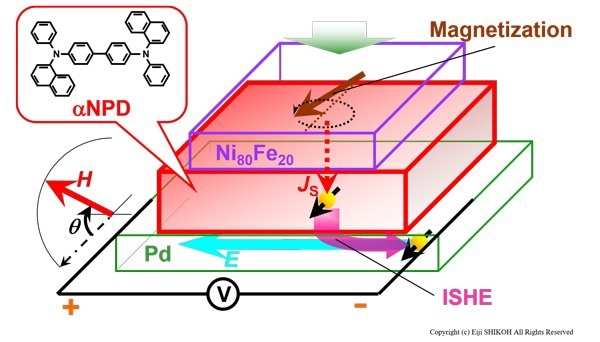As microfabrication technology develops, information processing devices—like smartphones—become more sophisticated due to an increase in information recording density. However, in recent years, processing has reached its physical limits, which makes further reduction challenging.
 Schematic illustration of the spin transport demonstration of αNPD molecular thin film-A three-layered sample consisting of a ferromagnetic metal Ni-Fe alloy film, an αNPD molecular film, and a palladium (Pd) film, prepared by vacuum deposition. Using spin pumping driven by ferromagnetic resonance (FMR) in the Ni-Fe alloy thin film, a spin current generated from the Ni-Fe alloy film went through the αNPD film and passed to the Pd film. Image Credit: ©Eiji Shikoh
Schematic illustration of the spin transport demonstration of αNPD molecular thin film-A three-layered sample consisting of a ferromagnetic metal Ni-Fe alloy film, an αNPD molecular film, and a palladium (Pd) film, prepared by vacuum deposition. Using spin pumping driven by ferromagnetic resonance (FMR) in the Ni-Fe alloy thin film, a spin current generated from the Ni-Fe alloy film went through the αNPD film and passed to the Pd film. Image Credit: ©Eiji Shikoh
A fundamental shift in operating principles could be necessary to enable the ongoing production of quicker, smaller, and newer gadgets to meet the increasing demand for more advanced technology.
The next generation of sophisticated electronics could be unlocked by a technique known as spintronics, which uses the magnetic spin and charge of electrons to satisfy this requirement. It is feasible to spread information using very little power and produce less waste heat by aligning a magnetic spin’s direction and moving it like an electric current.
Researchers from Osaka Metropolitan University’s Graduate School of Engineering, under the direction of Professors Eiji Shikoh and Yoshio Teki, have successfully measured spin transport at room temperature in a thin film of alpha-naphthyl diamine derivative (αNPD) molecules, a well-known component of organic light-emitting diodes.
They discovered that this molecular thin film has a spin diffusion length of about 62 nm, which they believe could be applied in real-world scenarios.
It is necessary to have a spin diffusion length in the tens of nanometer range at room temperature for precise processing to leverage spin transport to create spintronics technology.
For this study, a thin molecular film of αNPD was created by thermal evaporation in a vacuum, which has a spin diffusion length of 62 nm, a significant distance for molecular materials.
Since this new thin αNPD molecular film is photoconductive, spin transport can now be controlled using visible light instead of the conventional method of utilizing electricity.
For practical use, it will be necessary to uncover more details about spin injection and spin transport mechanisms through thin molecular films to control spin transport. Further research is expected to lead to the realization of super energy-efficient devices that use small amounts of power and have little risk of overheating.
Eiji Shikoh, Professor, Graduate School of Engineering, Osaka Metropolitan University
On December 8th, 2022, the study’s findings were published in the Solid State Communications’ online bulletin.
Grant-in-Aid from the Japan Society for the Promotion of Science (JSPS) for Scientific Research (B) (No. 20H02715) partly supported this study.
Journal Reference:
Onishi, Y., et al. (2023) Spin transport properties in a naphthyl diamine derivative film investigated by the spin pumping. Solid State Communications. doi:10.1016/j.ssc.2022.115035.